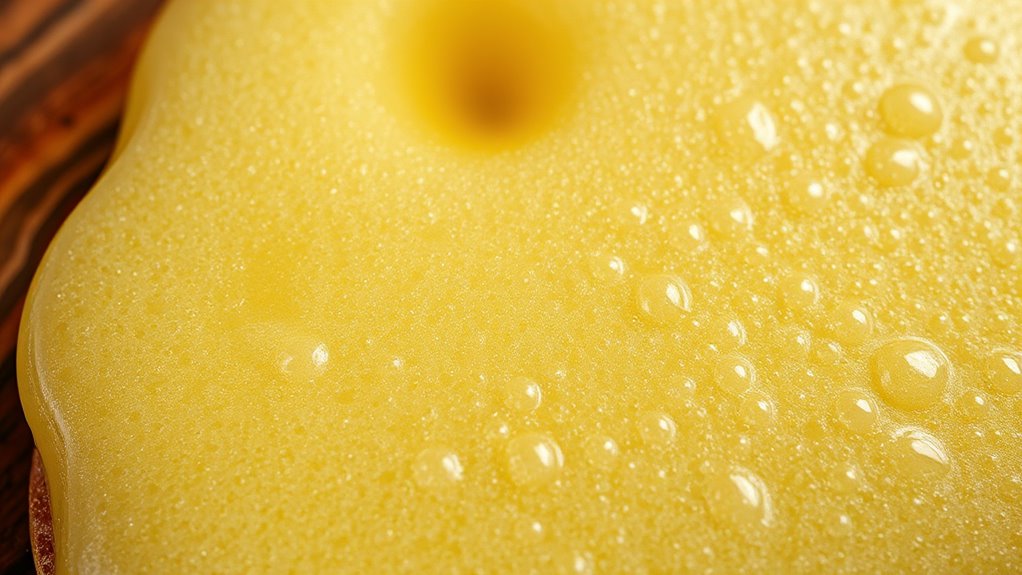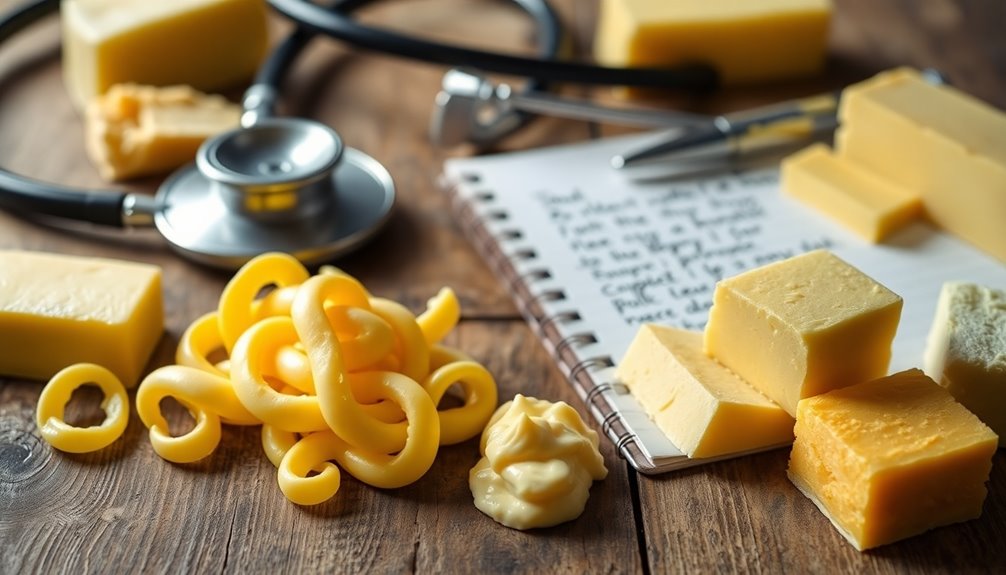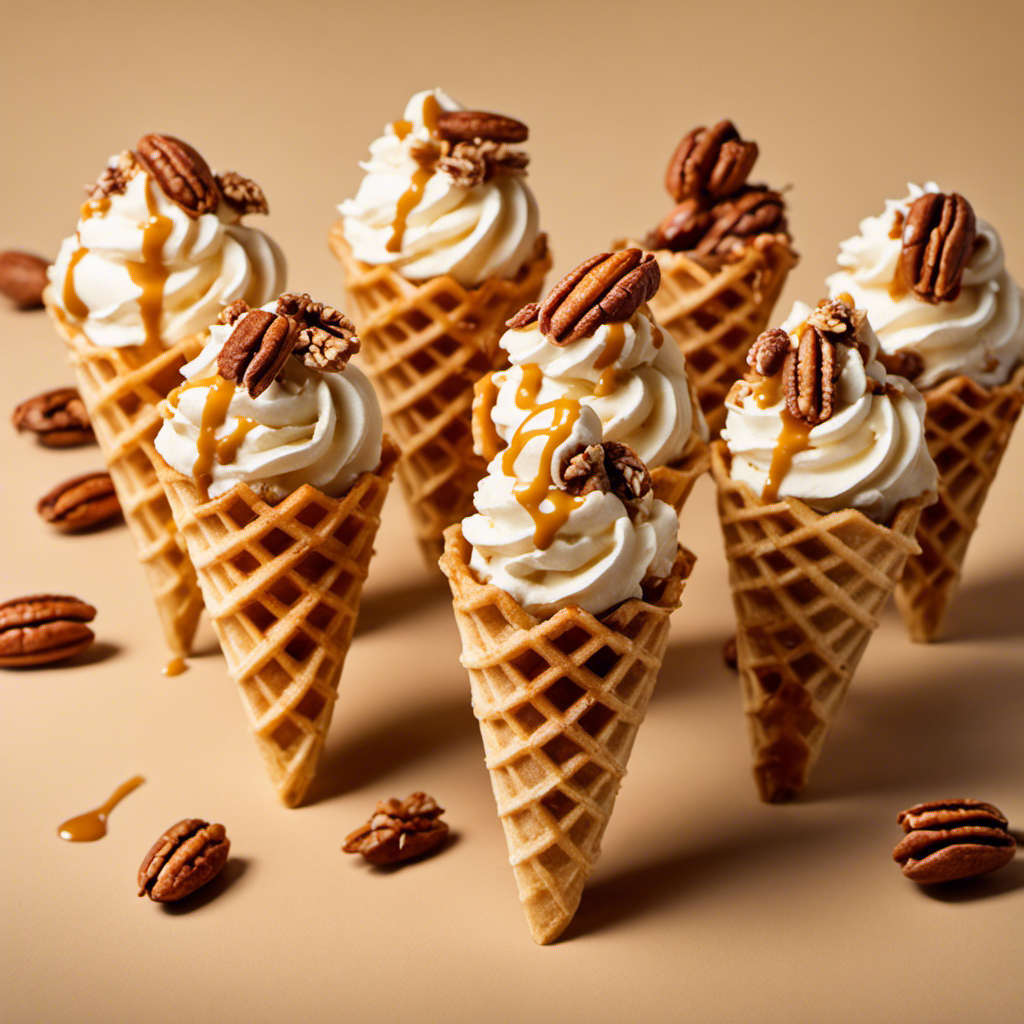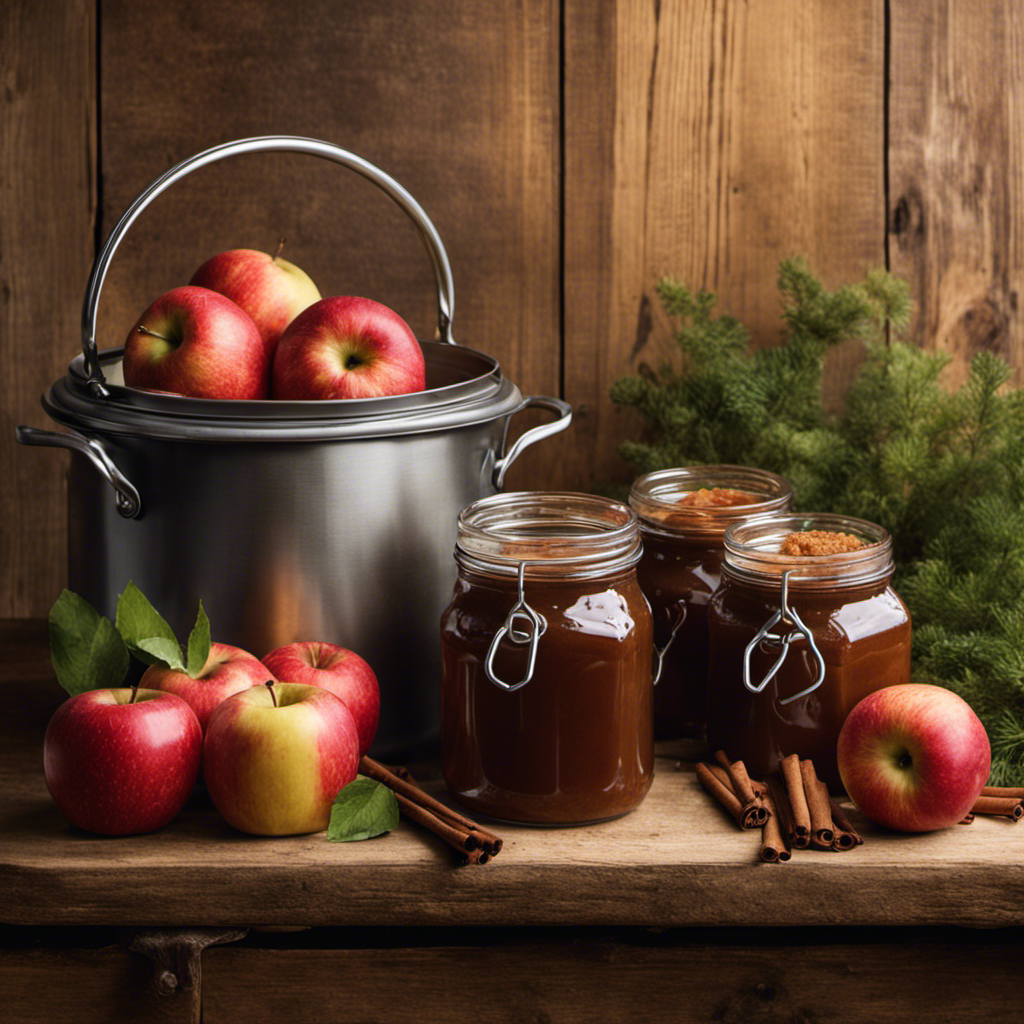Butter foams are made stable by the interplay of milk solids, water, and temperature. Milk proteins and fats work together to trap air bubbles, creating a light, airy texture. Water content influences foam strength, while temperature controls how proteins denature and fats melt, affecting stability and look. Making the perfect foam requires understanding these factors—truths you’ll explore further as you continue exploring the science behind butter foams.
Key Takeaways
- Milk solids, including proteins and fats, stabilize foam by forming a flexible network at the air-water interface.
- Proper water content ensures foam stability; too much water weakens the foam structure.
- Milk proteins unfold during whipping, trapping air and supporting foam stability and durability.
- Temperature control influences protein denaturation and fat melting, affecting foam texture and longevity.
- Emulsification disperses milk solids and water evenly, creating a stable environment for foam formation.
The Composition of Butter and Its Role in Foam Formation
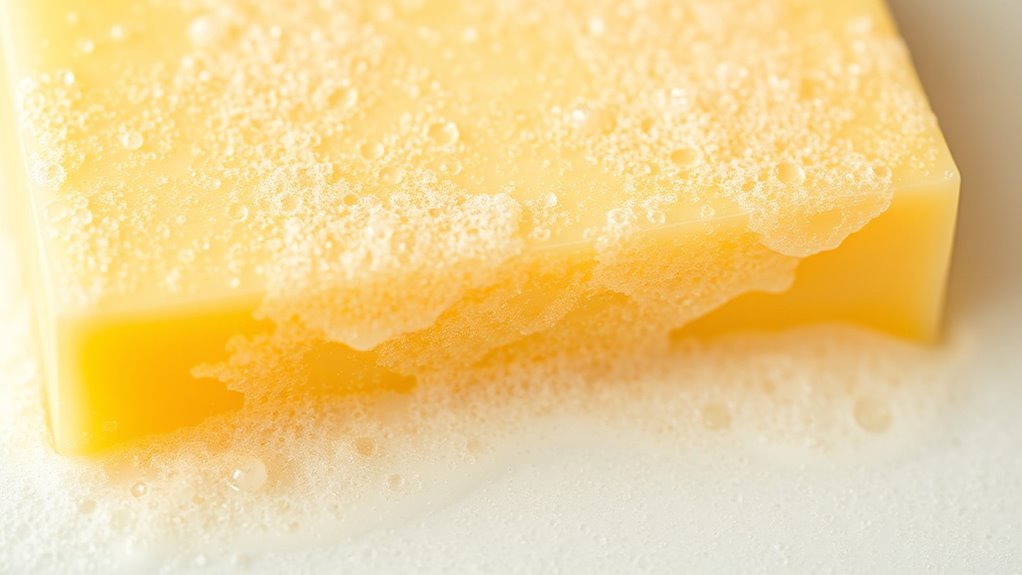
Understanding the composition of butter is essential to grasp how it forms foams. Butter’s makeup varies across cultures, reflecting different culinary traditions and processing methods. Historically, the evolution of butter production has influenced its properties, including how well it creates foams. For example, European butter often contains higher milk solids, which can enhance foam stability, while other regions may produce butter with more water content. These differences impact the texture and durability of butter foams in culinary applications. By understanding these cultural and historical factors, you can better appreciate how butter’s unique composition affects foam formation. Recognizing this diversity helps you manipulate temperature and technique to achieve the desired foam consistency. Additionally, butter’s composition—particularly the ratio of milk solids to water—plays a crucial role in determining foam quality and longevity.
How Milk Solids Contribute to Foam Stability

You’ll find that proteins in milk solids play a key role in strengthening the foam structure, making it more stable. Fat helps by stabilizing the bubbles and preventing them from collapsing. The overall milk composition influences how well the foam holds together, highlighting the importance of specific milk solids. Additionally, the composition of milk can affect how effectively the foam forms and persists over time.
Proteins Strengthen Foam
Proteins in milk play a crucial role in strengthening foam by forming a stable network at the air-water interface. This network traps air bubbles, making the foam more durable and resistant to collapse. As the proteins unfold and reorient, they create a flexible barrier that supports the foam’s structure. Beyond stability, these proteins also contribute to flavor enhancement, enriching the overall taste experience. Additionally, the presence of milk proteins offers nutritional benefits, providing essential amino acids in your diet. By stabilizing the foam, proteins help maintain its texture and appearance longer, ensuring a pleasing presentation. The dynamic behavior of milk proteins during foam formation is influenced by AI security considerations, which emphasize the importance of understanding material behavior. Their ability to improve both functional and nutritional qualities makes milk proteins essential for creating a well-structured, flavorful foam that lasts.
Fat’s Stabilizing Role
Milk fats, or milk solids, play a critical role in stabilizing foam by interacting with the other components at the air-water interface. These fats help form a cohesive barrier, preventing bubbles from merging or collapsing. Here’s how they work:
- They create a thin, protective film that enhances foam longevity, essential for the butter flavor you love.
- Their presence influences the texture, making the foam richer and creamier, which is a product of dairy farming expertise.
- They help trap water, maintaining moisture and preventing rapid drying or collapse of the foam.
- Additionally, milk solids composition affects how well the foam holds its structure over time, contributing to overall stability.
Milk Composition Impact
Have you ever wondered how the composition of milk influences the stability of its foam? Milk solids, including proteins and lactose, play a vital role in forming a stable foam and enhancing the butter flavor in culinary presentation. Higher milk solids improve the foam’s structure, helping it hold shape longer. Proteins, in particular, act as natural stabilizers, trapping air bubbles effectively. Water content affects the foam’s texture, with less water creating a richer, more stable foam. The table below highlights key components:
| Component | Effect on Foam Stability | Impact on Flavor |
|---|---|---|
| Proteins | Increase stability | Enhance butter flavor |
| Milk solids | Strengthen foam structure | Improve taste |
| Water content | Dilutes foam, reduces stability | Dilutes butter flavor |
Understanding milk composition helps you craft visually appealing, flavorful butter foams. Additionally, temperature control during foaming can significantly influence the final texture and stability of your butter foam.
The Impact of Water Content on Butter Foam Structure
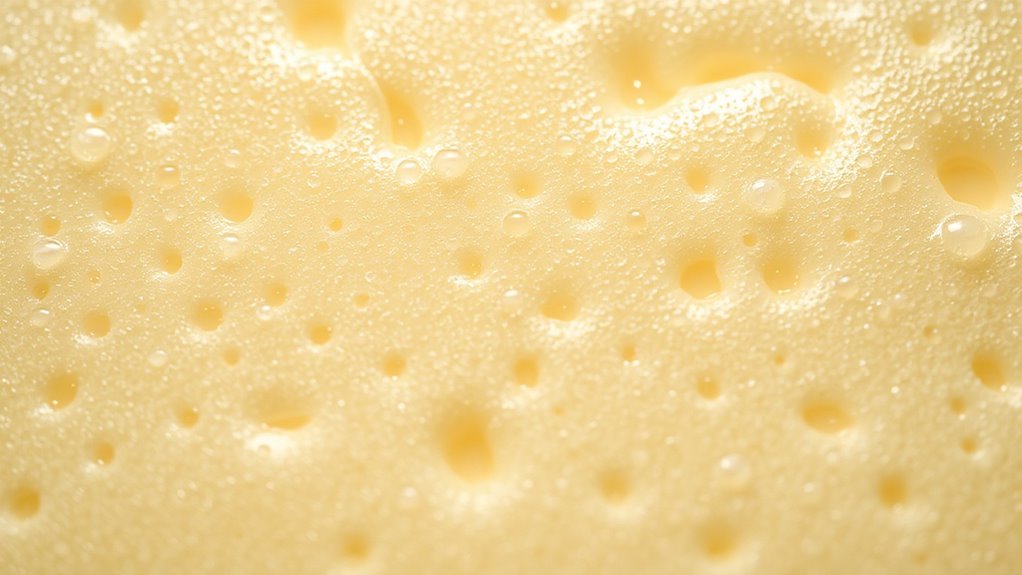
Water content plays a crucial role in shaping the structure of butter foams, as it directly influences the stability and texture of the foam. Too much water can weaken the foam, leading to rapid collapse, while too little reduces overall volume and creates a denser texture. Consider these key points:
Optimal water content ensures a light, stable butter foam with ideal texture.
- Higher water content increases the liquid phase, which can compromise foam stability.
- Lower water levels strengthen the fat and protein network, enhancing longevity.
- Ideal water balance results in a light, airy foam with improved texture.
- The tuning of water levels in butter foam is essential to achieve the desired consistency and stability.
Temperature Effects on Milk Proteins and Fat Behavior
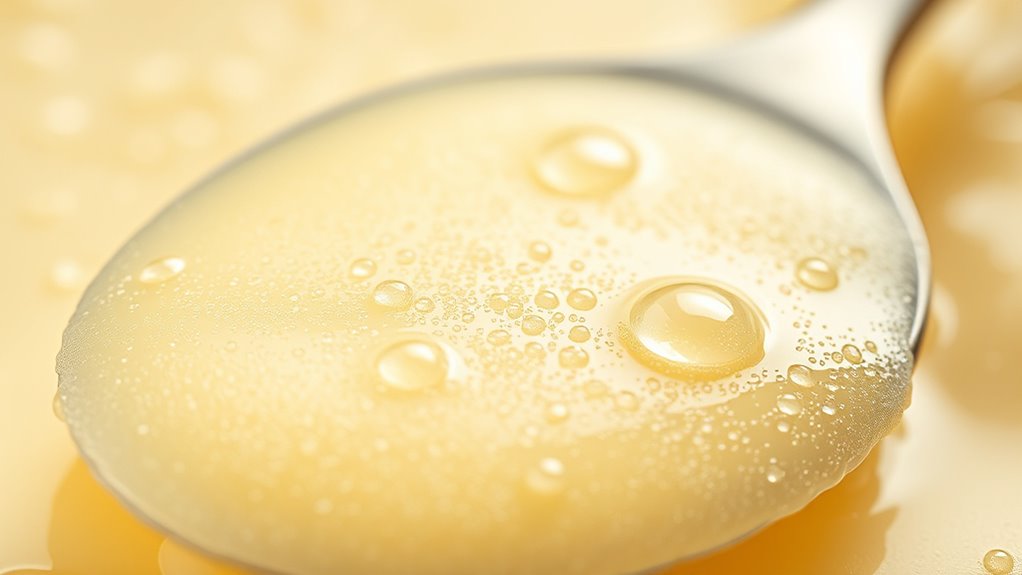
As you increase the temperature, milk proteins begin to denature, affecting their ability to stabilize foam structures. Simultaneously, the fat’s melting point influences how it behaves, impacting foam stability and texture. Understanding these temperature-driven changes helps you control the quality of your butter foams precisely. Attention in creative practice plays a crucial role in observing these subtle changes and refining your technique.
Protein Denaturation Dynamics
Temperature plays a crucial role in shaping the behavior of milk proteins and fats during foam formation. As temperature rises, proteins denature, altering their structure and affecting foam stability. Here’s what you need to know:
- Denaturation causes proteins to unfold, exposing hydrophobic regions that promote lipid interactions, helping stabilize the foam.
- Elevated temperatures accelerate water evaporation, concentrating proteins and fats, which influences foam texture.
- The balance between protein unfolding and lipid interactions determines foam firmness and resilience during whipping.
- Proper temperature control is essential for maintaining cookie categories and ensuring optimal foam quality.
Understanding these dynamics helps you control foam quality. Too much heat can cause over-denaturation, weakening the foam, while ideal temperatures enhance structure. Mastering this balance ensures your butter foam attains perfect lightness and stability.
Fat Melting Points
Understanding the melting points of milk fats is essential for controlling butter foam quality because these temperatures directly influence fat behavior during whipping. When fats melt at specific temperatures, they release tiny droplets that stabilize the foam, enhancing texture. Temperature management affects flavor complexity, as melting fats can intensify or mellow flavors depending on how thoroughly they liquefy. Additionally, fat melting impacts color variations in butter, with higher temperatures sometimes causing a darker hue due to heat-induced changes. Knowing these melting points helps you optimize whipping conditions, ensuring a consistent, stable foam with desirable flavor and appearance. Controlling temperature also influences the texture and stability of the foam, which is crucial for achieving the perfect culinary result. By controlling temperature, you can manipulate fat behavior, resulting in butter foams that meet your specific sensory and aesthetic expectations.
Emulsification Processes in Butter Foams
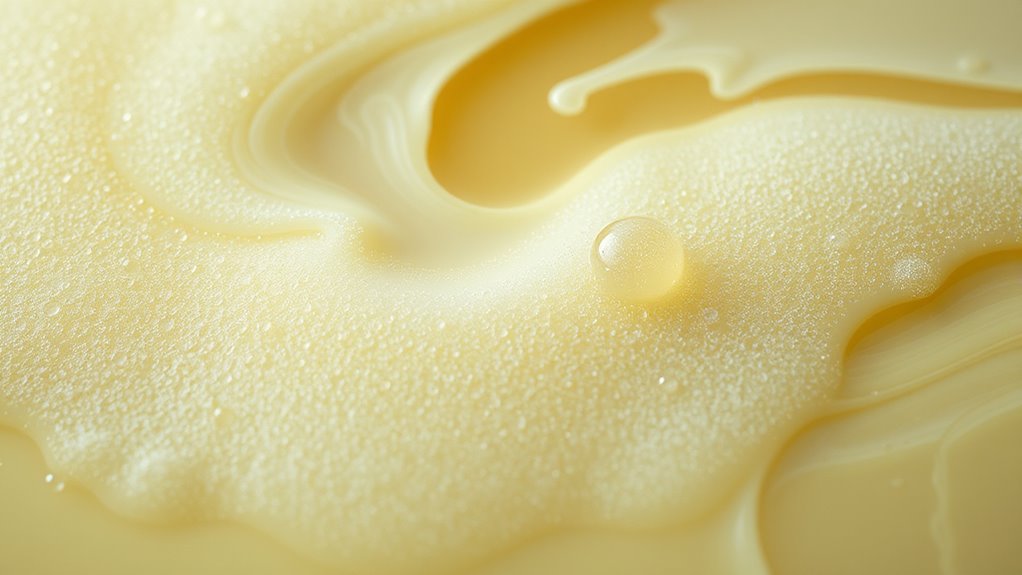
The process of emulsification plays a crucial role in forming stable butter foams by evenly dispersing milk solids and water within the fat matrix. Your goal is to create a uniform structure through lipids interactions, which stabilize the foam. First, you must understand how effective air incorporation depends on the emulsification process. Second, proper mixing helps break down fat globules, promoting better lipid interactions. Third, controlling temperature ensures the right viscosity for stable foam formation. When you emulsify, you facilitate the dispersion of water and milk solids, which act as natural stabilizers. This creates a network that traps air bubbles, maintaining foam stability. Mastering these steps allows you to produce butter foams with a light, airy texture, thanks to precise emulsification. Additionally, understanding the reservoir system in self-watering pots can provide insights into how moisture is consistently supplied and retained during the process.
The Science of Gas Incorporation in Butter

Gas incorporation in butter relies on carefully controlled processes that allow air or other gases to be introduced and stabilized within the fat matrix. This process enhances flavor by creating a subtle, airy texture that releases aromas more effectively. It also improves visual aesthetics, giving the butter a light, fluffy appearance that appeals to the eye. To achieve this, techniques like whipping or aeration are used, ensuring gas bubbles are evenly distributed and resistant to collapse. The stability of these bubbles depends on factors such as temperature, milk solids, and water content, which influence how well the foam maintains its structure. Proper gas incorporation not only elevates the sensory experience but also makes butter more visually enticing, encouraging consumption and culinary creativity.
Factors Influencing the Longevity of Butter Foams
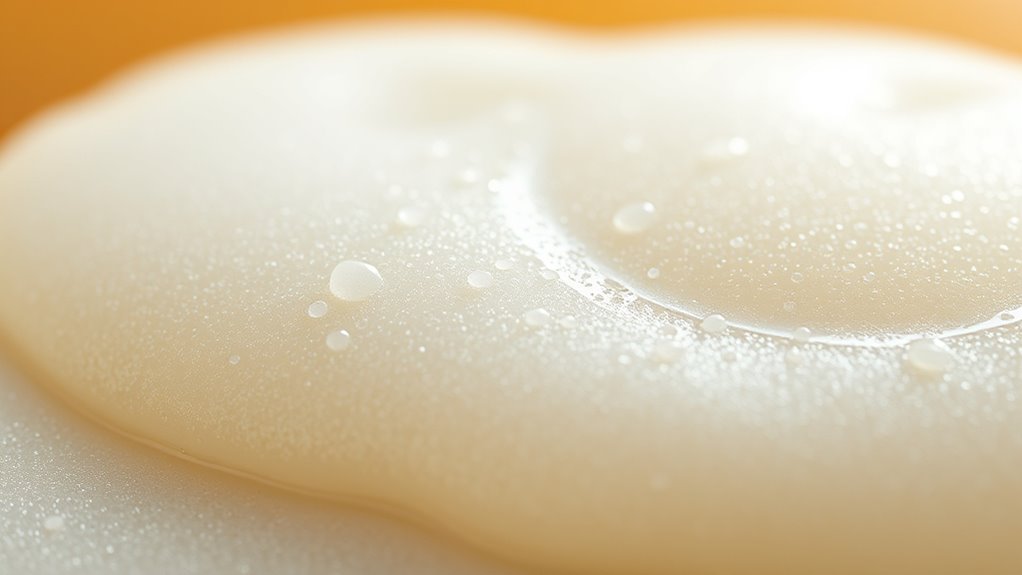
The stability and longevity of butter foams hinge on several interconnected factors that influence how well gas bubbles remain dispersed over time. First, fat content plays a vital role, as higher fat levels help trap air and preserve the foam’s structure, enhancing visual presentation. Second, temperature affects foam stability; cooler temperatures slow down melting and water migration, maintaining the foam’s form longer. Third, the incorporation method matters—gentle, even mixing prevents bubble collapse and ensures consistent size, boosting flavor enhancement and appearance. These factors work together to keep your butter foam looking airy and enticing, while also preserving its flavor. By controlling these elements, you can extend the foam’s lifespan, guaranteeing your dish looks stunning and tastes rich for as long as possible.
Comparing Butter Foams to Other Dairy-Based Foams
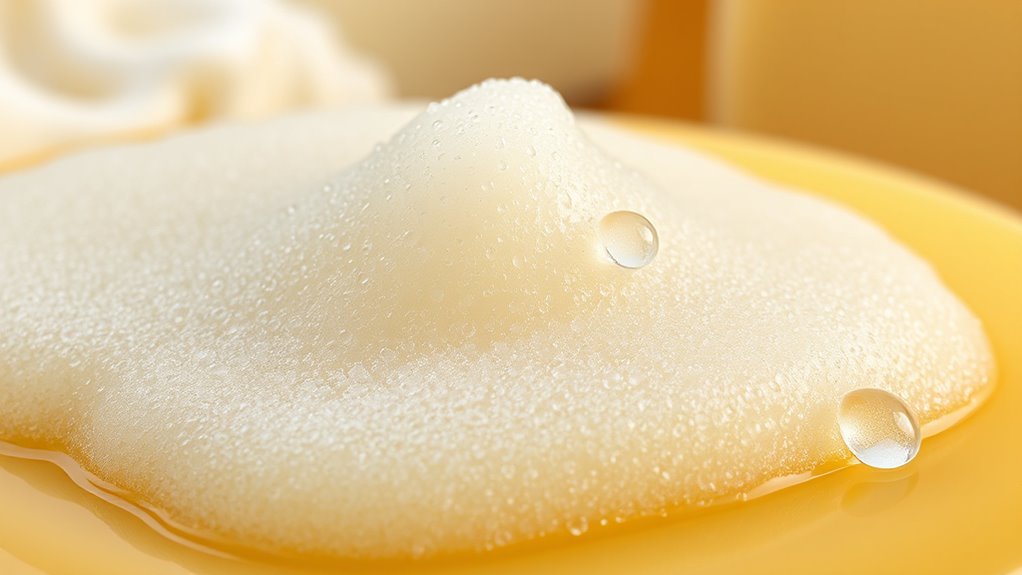
When comparing butter foams to other dairy-based foams, you’ll notice differences in texture and creaminess that affect how they feel on the palate. Stability and longevity also vary, influencing how long each foam maintains its form during service. Understanding these distinctions helps you choose the right foam for your culinary needs.
Texture and Creaminess
Compared to other dairy-based foams, butter foams stand out with their rich, velvety texture and luxurious creaminess. This enhances flavor perception and elevates the visual presentation of dishes. Here’s what makes them exceptional:
- Creamy Mouthfeel: You’ll notice how butter foams provide a smooth, indulgent sensation that melts effortlessly, amplifying flavor enhancement.
- Visual Appeal: Their glossy, dense appearance adds a refined, appetizing look to plates, making presentation more enticing.
- Flavor Depth: The natural richness of butter amplifies subtle flavors, creating a more complex, satisfying experience.
These qualities make butter foams a go-to for chefs aiming to impress both the palate and the eye, delivering a superior sensory experience.
Stability and Longevity
While butter foams excel in delivering a luxurious texture, they often face challenges in maintaining stability and longevity compared to other dairy-based foams. Butter’s high fat content can cause the foam to collapse more quickly, reducing its lifespan. This instability limits their effectiveness for flavor enhancement, as the foam may lose its delicate aroma and taste over time. In culinary presentation, butter foams may appear less consistent and less able to hold intricate shapes or structures. To improve stability, chefs often need to incorporate stabilizers or serve the foam immediately after preparation. Despite these challenges, butter foams add a rich, decadent element that can elevate the sensory experience, provided you prioritize their freshness and serve them promptly for maximum visual and flavor impact.
Techniques for Achieving Perfect Butter Foams
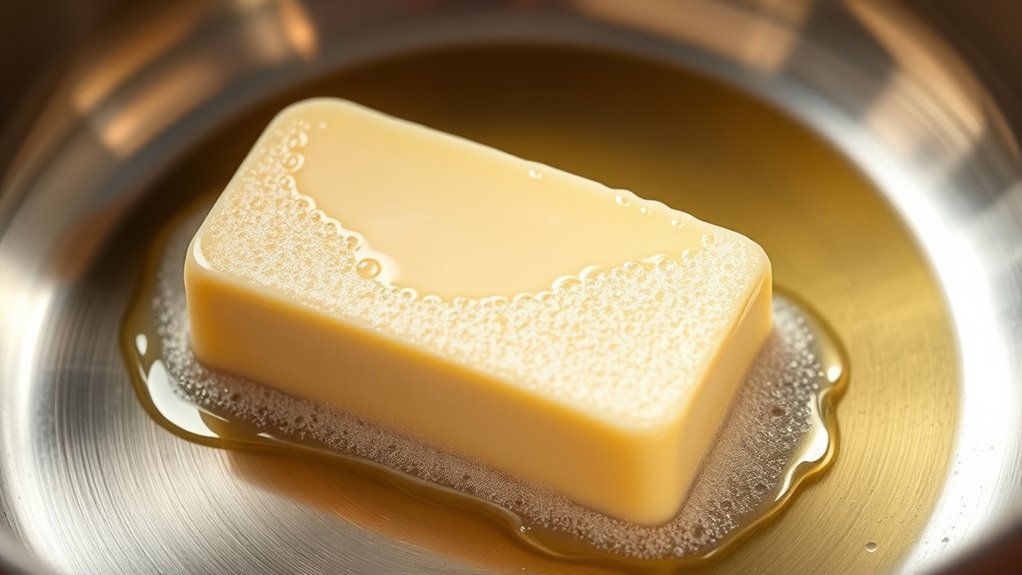
Achieving perfect butter foams requires careful control of temperature, solids, and technique. Cultural variations influence how butter is whipped, with some traditions emphasizing lower temperatures for richer textures, while others favor higher temps for stability. Historical developments show that early techniques relied on manual whisking, gradually evolving with tools like hand-held mixers and siphons. To master the art, focus on these key steps:
- Use cold, fresh butter to maximize solids and water content.
- Whip at precise temperatures—around 4°C (39°F)—to ensure ideal foam formation.
- Incorporate techniques like gentle folding or aeration to maintain foam stability and prevent collapse.
Practical Applications and Creative Uses of Butter Foams
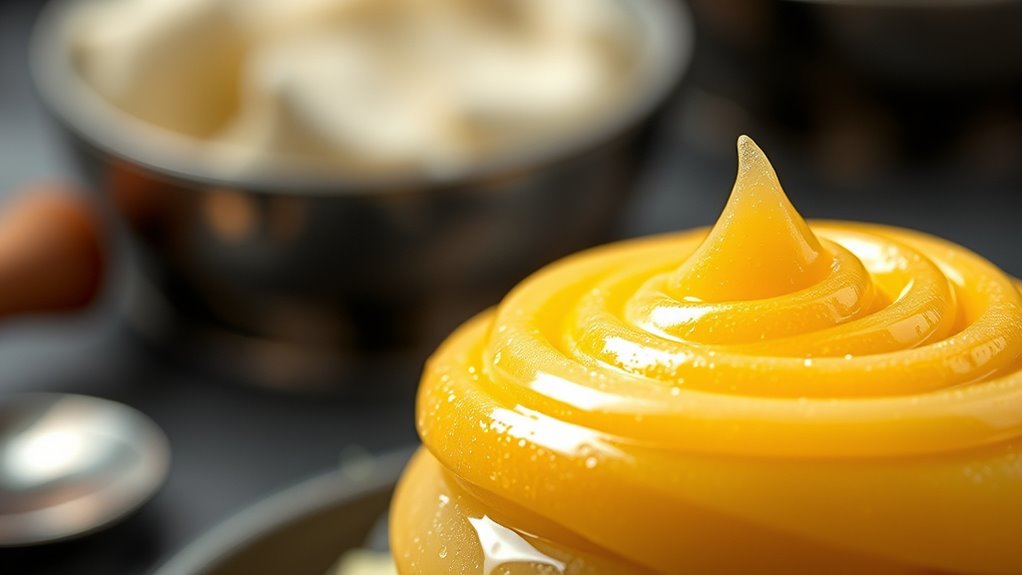
Butter foams open up a world of culinary creativity, transforming simple ingredients into visually stunning and flavorful dishes. You can use them to add a rich, buttery flavor to desserts, appetizers, or main courses, elevating your culinary presentation. Imagine topping a soup with a delicate butter foam to enhance both aroma and texture, or decorating a plated dessert with a light, airy layer that complements the sweetness. These foams can serve as edible garnishes, offering a sophisticated touch that surprises your guests. Their versatility allows for playful experimentation—pair them with herbs, spices, or even savory elements. With butter foams, you turn ordinary dishes into memorable, artful creations that captivate the senses and showcase your culinary skill.
Frequently Asked Questions
How Does the Fat Content Influence Butter Foam Stability?
You’ll find that higher fat content improves butter foam stability because fat globules strengthen the emulsion. During whipping, the emulsification process traps air within the fat globules, creating a stable foam. More fat means more globules to support the structure, resisting collapse. So, when you increase fat content, you get a denser, more resilient foam, as the fat globules effectively maintain the air pockets against breaking down.
Can Additives Improve the Longevity of Butter Foams?
Think of butter foams as delicate symphonies in your hands, where additives can be the subtle conductors extending their lifespan. You can boost longevity with safe, flavor-enhancing additives that stabilize the foam’s structure without compromising taste. Just make certain these additives are food-grade and tested for safety, so your culinary harmony remains pure and delightful. With careful choice, your butter foam’s fleeting beauty can be preserved longer, enchanting every bite.
What Role Does Ph Play in Foam Formation?
You might wonder how pH impacts foam formation. By adjusting the pH balance, you influence acidity levels, which directly affect protein stability in milk. A lower pH increases acidity, helping proteins unfold and trap air more effectively, creating better foams. Conversely, a higher pH reduces acidity, making it harder for proteins to stabilize foam. So, controlling pH is key to achieving the perfect butter foam consistency.
How Does Aging Affect Butter’s Foaming Properties?
You might find it surprising, but butter aging can markedly change its foam texture. As butter ages, its fat structure alters, weakening its ability to trap air and produce stable foam. This results in a less airy, more dense foam. If you want a light, fluffy foam, fresh butter is your best bet, because aging diminishes the butter’s capacity to hold those delicate bubbles, impacting the overall foam quality.
Are There Differences in Foam Behavior Between Artisanal and Commercial Butter?
You’ll notice that artisanal butter often has more consistent foam behavior compared to commercial butter. This is because artisanal processes prioritize minimal processing, preserving natural milk solids and water content, which enhances foam stability. Commercial processing can introduce additives and homogenization, affecting foam quality. So, your experience with butter foaming depends on these differences, with artisanal butter typically offering better, more predictable foam performance due to its traditional, less altered nature.
Conclusion
As you explore the delicate dance of butter foams, remember that mastering the balance of milk solids, water, and temperature is like tending a gentle flame—steady and attentive. With patience, you’ll craft airy, resilient textures that resemble soft clouds drifting across a clear sky. By understanding these subtle factors, you’re gently guiding your creations toward perfection, transforming simple ingredients into delightful masterpieces that evoke both warmth and wonder.
